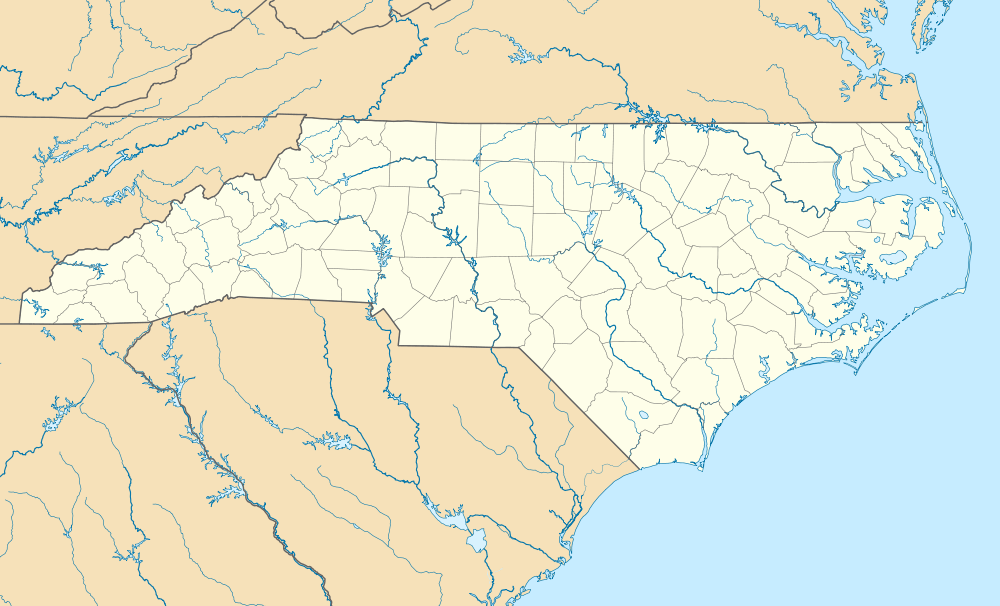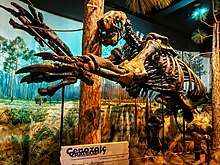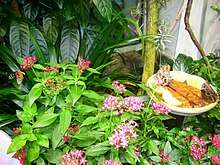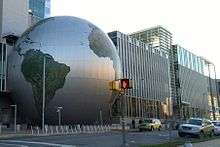North Carolina Museum of Natural Sciences
The North Carolina Museum of Natural Sciences (NCMNS) is located in Raleigh, North Carolina as the oldest established museum in North Carolina and the largest museum of its kind in the Southeastern United States. With about 1.2 million visitors annually,[1][2] as of 2013 it was the state's most popular museum or historic destination among visitors.[3]
 | |
 Location within North Carolina | |
| Established | 1879 |
|---|---|
| Location | Raleigh, North Carolina |
| Coordinates | 35.782186°N 78.639422°W |
| Type | Natural history museum |
| Visitors | 1.2 million (annually) |
| Director | Eric Dorfman |
| Website | naturalsciences |
The museum has four facilities on three campuses: the Nature Exploration Center and Nature Research Center on Jones Street in downtown Raleigh, the Prairie Ridge Ecostation satellite facility and outdoor classroom in northwest Raleigh near William B. Umstead State Park, and the former North Carolina Museum of Forestry in Whiteville. NCMNS is a division of the state Department of Natural and Cultural Resources.[4]
History

The North Carolina State Museum was created in 1879, by combining two existing state-owned collections of geologic and agricultural specimens.[5] The museum was originally housed in the Briggs building on Fayetteville Street.[6] The museum's collections, outreach and education programs, and status grew over the next 60 years under the stewardship of H.H. Brimley.[5] As part of the Department of Agriculture, the State Museum moved in 1887 to a former hotel on Edenton Street across from the Capitol building.[7] An annex was added in 1899, but the entire facility was replaced by a purpose-built building in 1924.[7] The facility was later renamed the North Carolina State Museum of Natural History.
In the 1950s and again in the 1990s, shifts in education further expanded the museum's holdings as universities donated their collections to the state.[5] In 1986, it became the North Carolina State Museum of Natural Sciences.[6]
A new building opened later and NCMNS became the largest natural history museum in the Southeast.[5] Also in 2000, the museum expanded with a new location: the Museum of Forestry in Whiteville was added as a satellite campus; this facility was later overhauled and reopened in 2015 as the NC Museum of Natural Sciences in Whiteville.[5] Another location was added in 2004, with the opening of the Prairie Ridge Ecostation for Wildlife and Learning.[5] The museum expanded its downtown campus in 2012, with the adjacent Nature Research Center.[5]
The collection now contains more than 1.7 million specimens[8] of amphibians, reptiles, birds, fish, mammals, invertebrates, invertebrate and vertebrate fossils, plants, geology, and meteorites.[9]
NCMNS is administered by the Department of Natural and Cultural Resources.[10][4][6]
Nature Exploration Center
First floor

- Natural Treasures of North Carolina contains dioramas of various wildlife and artifacts pertaining to nature in North Carolina.
- Coastal North Carolina includes exhibits of fish native to North Carolina's coast and inland waterways.
- WRAL 3-D Theater – 3-D films are shown daily in this 250-seat venue.
- Box Office
Second floor
- The North Carolina: Mountains to the Sea exhibit displays North Carolina's natural habitats from the western mountains through the central Piedmont and on to the Coastal Plain highlighting the interrelationships between them.
- Underground North Carolina features gems and minerals of North Carolina, as well as ground, soil, and seismic displays.
- The Nature's Explorers exhibit covers the museum's beginnings, showing the tools and techniques naturalists used 100 years ago to collect and preserve specimens.
- The Discovery Room is a family-oriented hands-on exhibit for exploring the natural world using a combination of natural, live, and human-made objects.
- Special Exhibition gallery.
- A bridge to the museum's new building, which also has a timeline on display.
Third floor

- Prehistoric North Carolina chronicles prehistoric life in the state and throughout the southeastern United States.
- The Terror of the South exhibit features fossil skeletons, including an Acrocanthosaurus.
- The Tropical Connections section is anchored by a large interactive globe which allows visitors to highlight the climate regions of the Earth. This exhibit focuses on environmental issues.
- In the Windows on the World theater, museum volunteers and employees give frequent demonstrations and talks, and share live animal visits with museum visitors as well as remotely to classrooms throughout the state.
- Two Curiosity Classrooms spaces
- Another bridge
- A dinosaur short film in a room
Fourth floor
- Arthropod Zoo – Live and static exhibits of the insects, crustaceans, arachnids and other arthropods in North Carolina.
- Living Conservatory – A dry tropical forest exhibit with various live plants and animals, including butterflies and a two-toed sloth. A windowed chamber preceding the exhibit displays chrysalides of developing butterflies, and butterflies that have recently emerged.
 Butterflies in the living conservatory.
Butterflies in the living conservatory. - Acro Café
Nature Research Center

The Nature Research Center (NRC) is an 80,000 sq ft (7,400 m2), four-story wing across the street from the Nature Exploration Center.[11] The NRC and NEC are connected by a breezeway.[12] The April 20, 2012, opening lasted 24 hours and drew 70,000 visitors.[13]
The NRC provides hands-on activities and visitor-viewing of scientists working in the NRC's four research laboratories. The museum also makes use of distance learning to broadcast lessons and virtual field trips to classrooms around the state.[14][15]
First floor
- SECU Daily Planet Theater – Inside the globe, a three-story theater hosts science presentations and scenes from nature.[16]
- Our Changing Ocean – A 10,000 US gal (38,000 l) aquarium replicates a typical hardbottom habitat off the North Carolina coast.
- Investigating Right Whales – Visitors can see and touch the skeleton of "Stumpy",[17] a North Atlantic right whale whose death[18] led to laws that require slower cargo ship speeds in whale migration routes.
- Exploring the Deep Sea – A model submersible takes visitors on a virtual dive 2,000 ft (610 m) to the ocean floor off the North Carolina coast.
- Exploratory Gallery – Presents projects and breakthroughs in engineering, health and modeling.
- Citizen Science Center – Exhibits on getting involved in scientific research and being a citizen scientist.
- North Carolina's Green Gems – Emeralds discovered in North Carolina, including North America's largest cut emerald, the 64.8-carat Carolina Emperor.[19][20]
- Giftshop
Second floor
- Researching Weather displays methods used to study the weather.
- Window on Animal Health – Visitors can view veterinary staff, students, and interns working on real medical procedures. The Window is equipped with 2-way audio between visitors and staff and offers video for visitors to view close-ups of microscopic images and medical procedures. Patients include species such as reptiles, amphibians, fish, birds, small mammals and invertebrates.[21]
- Naturalist Center – Features some of the museum's 20,000 education specimens ranging from fossils and bones to preserved reptiles and birds. This exhibit also showcases audio and video of certain specimens at two interactive tabletops.
Third floor
- Unraveling DNA – DNA replication and model organisms.
- From Dinosaurs to DNA – new tools and techniques that are helping scientists study the natural world.
- Postcards from Space – collection of meteorites.
- Ice Age Giants – An exhibit showing that, although glaciers never reached North Carolina, climate changes may have spelled doom for the Ice Age animals that roamed the state.
- Early Life Explosion – Displays of Ediacaran fossils representing some of the earliest complex life on Earth (542-635 million years ago).
Investigate labs
The Nature Research Center's three investigate labs are open-to-the-public hands-on educational spaces.
- Natural World Investigate Lab (second floor) – Visitors can use a variety of tools to observe and study the natural world.
- Micro World Investigate Lab (third floor) – This lab focuses on the future of biotechnology and microbiology, from protozoa to genetic engineering.
- Visual World Investigate Lab (third floor) – Modeling and simulation technologies that help scientists visualize nature in new ways, including how a robot works and classes in electronics and computer programming.
Research labs
The Nature Research Center's four research labs are part of the museum's Research and Collections department. These spaces (normally reserved for behind-the-scenes work) have transparent glass walls through which the public can observe firsthand as research scientists do their work. The atrium is home to the LCD sculpture Patterned by Nature.
- Biodiversity and Earth Observation Research Laboratory (second floor) – This laboratory is the center for exploration of the flora and fauna of the community, state and planet. Studies focus on such areas as mammalian movement ecology.
- Astronomy and Space Observation Research Laboratory (third floor) – Astronomers in this lab use large telescopes around the world to investigate the origins of the solar system by studying the chemical composition of gas clouds around forming stars.
- Genomics and Microbiology Research Laboratory (third floor) – In this lab, Biologists conduct a wide spectrum of molecular genetic studies to examine DNA-based relationships among primates (called comparative evolutionary genomics) and more.
- Paleontology and Geology Research Laboratory (third floor) – The focus of this laboratory is the morphology, evolutionary relationships and paleoecology of theropod dinosaurs—a group that includes the iconic megapredator Tyrannosaurus rex as well as living birds.
Prairie Ridge Ecostation
Prairie Ridge Ecostation (45 acres (180,000 m2)) is a satellite facility and outdoor classroom located 6 miles (9.7 km) from the museum's downtown Raleigh locations. It includes Piedmont prairie, forest, ponds, a stream and sustainable building features integrated with a wildlife-friendly landscape.[22]
Prairie Ridge furthers the museum's mission of enhancing public understanding and appreciation of the natural environment by providing an outdoor learning space while acting as a model for renewable and sustainable energy.
The facility opened a Nature PlaySpace Saturday, September 28, 2013.[23]
North Carolina Museum of Natural Sciences at Whiteville
The North Carolina Museum of Natural Sciences at Whiteville, formerly known as the North Carolina Museum of Forestry, is a satellite facility of the North Carolina Museum of Natural Sciences located in Whiteville, North Carolina. Its mission is to celebrate the natural history and cultural heritage of North Carolina's forests through interpretive exhibits, educational programming and the preservation of natural and man-made materials that demonstrate the ongoing relationship of forests and people.
Displays and interactive exhibits include an outdoor Tree Trail and Fossil Dig Pit, and the museum offers educational program experiences and special events.
Notable annual events
NCMNS hosts many special events through the year. The most notable are:
On Groundhog Day, February 2, Sir Walter Wally makes his annual prediction for the arrival of the upcoming spring. Sir Walter has a 58% accuracy rating,[24] which has earned him nationwide recognition for his prognostication ability.[25][26]
BugFest, held in mid-September every year, is a free day-long festival devoted to insects.[27] This event attracts more than 35,000 visitors per year.[27] A smaller version of the festival, called BugFest South, is held at the Whiteville facility in May or June.[28][29]
NCMNS participates in First Night Raleigh each year on December 31.[30][31] In 2012, First Night drew 80,000 people to the blocks around the museum.[32]
References
- "NC Museum of Natural Sciences is state's top draw". Associated Press. Associated Press. 2013-03-04. Retrieved 2013-08-16.
- William S. Powell; Jay Mazzocchi (associate), eds. (2006). Encyclopedia of North Carolina. Chapel Hill: University of North Carolina Press. ISBN 0807830712.
- "NC Museum of Natural Sciences is state's top draw". WRAL.
- "Our Nature Programs". N.C. Department of Natural and Cultural Resources. State of North Carolina. Retrieved 18 February 2016.
- "MUSEUM HISTORY". North Carolina Museum of Natural Sciences. Retrieved February 8, 2017.
- "H-35: N.C. STATE MUSEUM OF NATURAL SCIENCES". North Carolina Highway Historical Marker Program. North Carolina Office of Archives & History (Department of Cultural Resources). 2008. Retrieved February 8, 2017.
- Larson, Karl (September 26, 2014). "State Agricultural Bldg., Raleigh, N.C." Goodnight Raleigh. Retrieved February 8, 2017.
- Pishney, Jonathan (2007), Collecting Nature: The Beginning of the North Carolina Museum of Natural Sciences (PDF), North Carolina Museum of History, Office of Archives and History, N.C. Department of Cultural Resources, archived from the original (PDF) on July 20, 2012
- "COLLECTIONS". North Carolina Museum of Natural Sciences. Retrieved February 8, 2017.
- "NC Department of Natural and Cultural Resources". www.ncdcr.gov. Retrieved 2017-07-18.
- Nature Research Center Fact Sheet (PDF), North Carolina Museum of Natural Sciences, archived from the original (PDF) on October 18, 2011
- "Tar Heel of the Year: Betsy Bennett transforms state science museum". The News & Observer. Raleigh, North Carolina: The News & Observer Publishing Co. January 1, 2012. Archived from the original on January 20, 2013. Retrieved 2013-08-22.
- Hui, T. Keung (April 22, 2012). "Opening of Nature Research Center draws 70,000 visitors". The News & Observer. Raleigh, North Carolina: The News & Observer Publishing Company. Archived from the original on April 23, 2012.
- "Raleigh's new "rock star" head scientists". The News & Observer. The News & Observer Publishing Company. April 15, 2012. Archived from the original on 2013-05-22.
- "Teachers throughout N.C. can plug into museum's work". The News & Observer Publishing Company. April 15, 2012. Archived from the original on 2013-05-23.
- Stradling, Richard (2011-08-29). "Science museum's latest marvel taking form in Raleigh". The News & Observer. Archived from the original on 2012-10-03. Retrieved 2011-08-09.
- Schreiber, Laurie (February 2012). "Right Whale Mother and Fetus Skeletons Reconstructed". Fishermen's Voice. 17 (2). Retrieved 2013-10-09.
- Dolman, Sarah; Williams-Grey, Vanessa; Asmutis-Silvia, Regina; Isaac, Steve (September 2006). "Vessel collisions and cetaceans: What happens when they don't miss the boat (A WDCS Science Report)" (PDF). Whale and Dolphin Conservation Society. p. 4. Archived from the original (PDF) on December 29, 2010.
- Gast, Phil (2010-09-01). "North Carolina emerald: Big, green and very rare". CNN. Cable News Network (Turner Broadcasting System, Inc.). Retrieved 2013-10-08.
- Stancill, Jane (2012-03-16). "N.C. gems to shine at museum". The News & Observer. The News & Observer Publishing Co. Archived from the original on 2012-03-27. Retrieved 2013-10-08.
- Stone, Cheryn (2013-03-17). "NC Museum of Natural Sciences exhibit gives students a glimpse into veterinary medicine". News 14 Carolina. TWEAN Newschannel of Raleigh, L.L.C. Archived from the original on January 12, 2015. Retrieved 2013-10-10.
- "Park Review: Prairie Ridge Ecostation". WRAL. Capitol Broadcasting Company, Inc. 2010-09-23. Retrieved 2013-07-12.
- "NC natural sciences museum builds 'backyard' in West Raleigh". News & Observer. The News & Observer Publishing Co. 2013-09-26. Retrieved 2013-10-17.
- Gargan, Henry (February 2, 2017). "What do groundhogs Sir Walter Wally and Snerd say about winter?". The News & Observer. Raleigh, North Carolina. Retrieved February 2, 2017.
- Martinez, Edecio (January 30, 2014), "Groundhog Day 2014: Top 11 Groundhogs to Watch (PHOTOS)", The Weather Channel, The Weather Company, retrieved February 2, 2017
- Abbey, Alison (January 28, 2017). "5 Groundhogs to Watch (Besides Punxsatawney Phil)". Parade. AMG/Parade. Retrieved February 2, 2017.
- Hill, Corbie (September 12, 2016). "Museum puts ants under the magnifying glass for BugFest 2016". The News & Observer. Raleigh, North Carolina. Retrieved February 2, 2017.
- Woolverton, Paul (June 8, 2015). "BugFest festival celebrates insects in Whiteville June 13". The Fayette Observer. Whiteville, North Carolina. Retrieved February 8, 2017.
- "BugFest South". North Carolina Museum of Natural Sciences. Retrieved February 2, 2017.
- "First Night Raleigh". North Carolina Museum of Natural Sciences. Retrieved February 2, 2017.
- Hill, Corbie (December 29, 2016). "First Night Raleigh – and 11 other ways to kick 2016 out the door". The News & Observer. Retrieved February 8, 2017.
- "About". 2017 First Night® Raleigh, NC. 2017. Archived from the original on February 11, 2017. Retrieved February 8, 2017.
